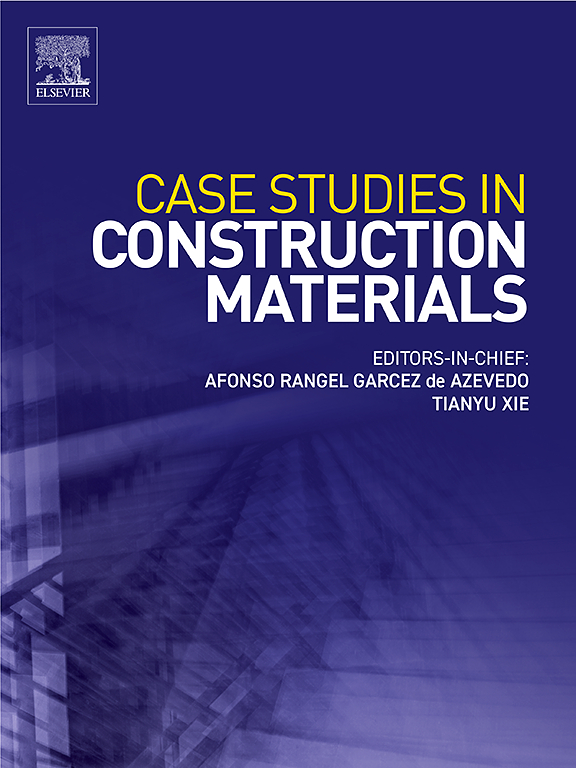The influence mechanism of wet-ground ultra-fine granulated blast furnace slag on the shrinkage cracking sensitivity of cementitious materials based on the eccentric ring test
IF 6.6
2区 工程技术
Q1 CONSTRUCTION & BUILDING TECHNOLOGY
引用次数: 0
Abstract
Improving the hydration activity of supplementary cementitious materials (SCMs) through ultra-refinement to enhance their application in concrete is a critical development direction for achieving both low carbon emissions and high performance. However, ultrafine SCMs may reduce workability and increase risk of early shrinkage cracking of cementitious materials. In this research, ordinary and wet-ground ultra-fine granulated blast furnace slag (WGGBS) were selected as the subjects of study. The shrinkage and cracking performance of the two types of ultra-fine GGBS cementitious materials were characterized by the eccentric ring test. The cracking risk at various positions of the eccentric ring specimen was analyzed through theoretical analysis in the bipolar coordinate system. The effect of ultra-fine GGBS dosage on the hydration and pore structure of the cementitious materials was clarified. The results indicate that both types of ultrafine GGBS can accelerate the hydration of cement and promote the rapid refinement of pore structure, leading to an increase in the autogenous shrinkage of cementitious materials. Conversely, WGGBS cementitious materials exhibit lower porosity, improved water retention, and greater compressive strength at 7 days. WGGBS significantly reduces drying shrinkage and extends both the initial cracking and through-cracking times. The autogenous and drying shrinkage of cementitious materials are less sensitive to the content of WGGBS compared to OGGBS. WGGBS demonstrates more pronounced advantages in enhancing mechanical strength and crack resistance. This study provides theoretical support for the coordinated optimization of mechanical strength and resistance to shrinkage cracking in cementitious materials prepared with ultra-fine GGBS.
基于偏心环试验研究湿磨超细粒化高炉渣对胶凝材料收缩开裂敏感性的影响机理
通过超细化提高补充胶凝材料的水化活性,增强其在混凝土中的应用,是实现低碳排放和高性能的重要发展方向。然而,超细SCMs可能会降低胶凝材料的和易性,增加其早期收缩开裂的风险。本研究以普通和湿磨超细粒化高炉渣(WGGBS)为研究对象。采用偏心环试验对两种超细GGBS胶凝材料的收缩开裂性能进行了表征。通过在双极坐标系下的理论分析,分析了偏心环试件在不同位置的开裂风险。阐明了超细GGBS用量对胶凝材料水化和孔隙结构的影响。结果表明:两种超细GGBS均能加速水泥的水化,促进孔隙结构的快速细化,导致胶凝材料的自收缩增大;相反,WGGBS胶凝材料在7天内表现出更低的孔隙率、更好的保水性和更高的抗压强度。WGGBS显著降低了干燥收缩率,延长了初裂和透裂时间。与OGGBS相比,胶结材料的自收缩和干燥收缩对WGGBS含量的敏感性较低。WGGBS在提高机械强度和抗裂性能方面的优势更为明显。本研究为超细GGBS胶凝材料的机械强度和抗收缩开裂协同优化提供了理论支持。
本文章由计算机程序翻译,如有差异,请以英文原文为准。
求助全文
约1分钟内获得全文
求助全文
来源期刊

Case Studies in Construction Materials
Multiple-
CiteScore
7.60
自引率
19.40%
发文量
842
审稿时长
63 days
期刊介绍:
Case Studies in Construction Materials provides a forum for the rapid publication of short, structured Case Studies on construction materials. In addition, the journal also publishes related Short Communications, Full length research article and Comprehensive review papers (by invitation).
The journal will provide an essential compendium of case studies for practicing engineers, designers, researchers and other practitioners who are interested in all aspects construction materials. The journal will publish new and novel case studies, but will also provide a forum for the publication of high quality descriptions of classic construction material problems and solutions.
 求助内容:
求助内容: 应助结果提醒方式:
应助结果提醒方式:


